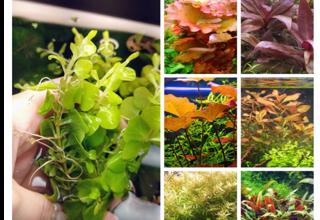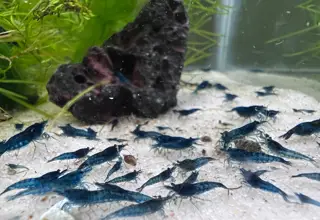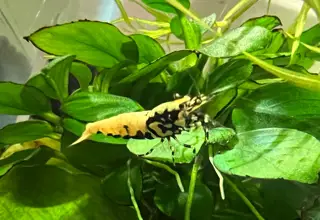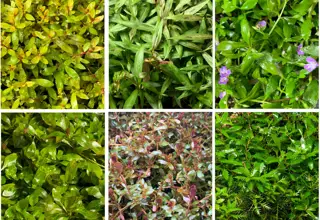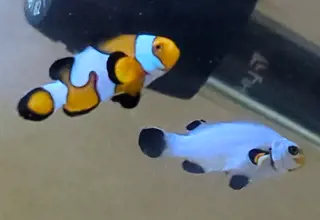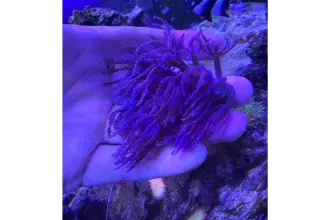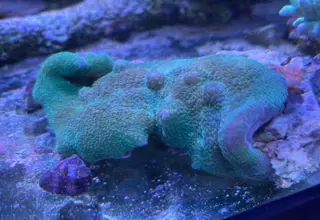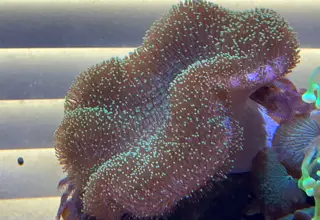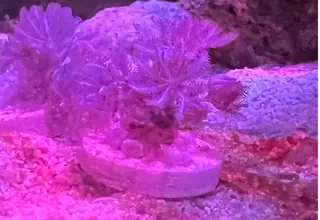Blue Spotted Puffer: Care, Acclimation, Appearance & More
Posted by on 2/11/2023
We use affiliate links and may receive a small commission on purchases.
Marine fish display some of the most vibrant colors seen in nature. While certain fish, such as wrasses, tangs, and clownfish are some of the more commonly seen brightly colored fish in the hobby, many less common species also display lively color patterns.
One of these fish is known as the Blue Spotted Puffer, and it's easy to understand why this fish is widely recognized by hobbyists. Known for its brightly-colored blue dots and ability to fill itself up like a balloon, the Blue Spotted Puffer is a fish that has a lot to offer. If you're deciding whether or not this fish is the right choice for you, we're going to cover all of the ins and outs when it comes to the species. We'll discuss best practices when it comes to their care and we'll also give recommendations on tank setup, tank mates, and much more.
Species Summary
Native to the Indo-Pacific, the Blue Spotted Puffer (scientific name: Canthigaster solandri) is a unique, ray-finned marine fish known for its striking appearance and ability to puff itself up to intimidate predators.
The fish is widespread throughout the Indonesian coasts, where they can be found swimming in tide pools and coral reefs. First scientifically classified by Scottish naturalist John Richardson , the species is a member of the Canthigaster genus, which is comprised of 37 species that are commonly referred to as "tobies". Members of this genus fall under the Tetraodontidae family, which encompasses all species of pufferfish that dwell in brackish, fresh, and saltwater environments.
These fish have specialized muscles, which they use to inflate themselves with water when threatened by potential predators. Similar to other puffer fish species, these fish produce tetrodotoxin , a chemical compound that's 1200 times more poisonous than cyanide. One puffer fish has enough poison that they're capable of killing up to 30 humans! While this may sound a bit intimidating, these fish are poisonous, not venomous, and unless you plan on eating these fish, you won't have much to worry about when it comes to your safety.

Appearance
The Blue Spotted Puffer is a vibrant-looking fish. Its large eyes sit at the top of its head, and a beak sits at the end of a pointed snout, one of the defining features of the Canthigaster genus.
These fish have a primarily orange body, covered in iridescent turquoise dots, and horizontal, curvy, stripes. Their dorsal, pectoral, and anal fins are translucent, and their black eyes are surrounded by brightly colored green and orange rings.
Female Blue Spotted Puffers will lack the iridescent lines seen on the back of a male's head.

Blue Spotted Puffer vs Papuan Toby Puffer
The Papuan Toby Puffer (scientific name: Canthigaster papua) is an incredibly similar-looking fish, with identical care requirements. Hobbyists looking to distinguish the difference between the two should closely examine the fish's mouth. While subtle, any orange coloration seen around the mouth and chin means it's a Papuan Toby, and not a Blue Spotted Puffer.

Size
Blue Spotted Puffers are relatively small fish, and will only grow to reach about 5 inches in length.
When purchased, these fish can be sold as juveniles, and may only be 1-2 inches in length. It's always important to inquire about the age of the fish when purchasing so that you can plan your aquarium accordingly to account for the fish's adult size.
Blue Spotted Puffer Care
Hobbyists can successfully keep the Blue Spotted Puffer in a marine aquarium, granted they're well-versed in their care requirements. These fish are active explorers, constantly searching for new food sources to fuel their carnivorous diets.
If you're considering adding a Blue Spotted Puffer to your saltwater aquarium, you'll want to re-create their natural habitat as best as possible. Luckily, with the proper setup, you can successfully keep this fish in captivity.
Lifespan
Blue Spotted Puffers, similar to other puffer fish, are a long-lived species. Provided a pristine environment and a nutrient-rich diet, the Blue Spotted Puffer can live for up to 10 years.
It's important to monitor and test your water chemistry, as subtle changes in ammonia, nitrite, and nitrate levels can cause stress, weakening your fish's immune system, and making them susceptible to fatal diseases. Regularly feeding your fish a well-balanced diet will reduce their stress levels and give them the best chance at living a long and healthy life.
Tank Size
The Blue Spotted Puffer should be kept in an aquarium no smaller than 50 gallons.
If budget allows, we recommend an even bigger tank. Larger aquariums tend to be more stable compared to nano aquariums and provide more flexibility if you're planning on adding future livestock. While the Blue Spotted Puffer can be a peaceful fish, territorial disputes are not uncommon.

Acclimation
Acclimation is a delicate process, and the Blue Spotted Puffer is no different than any other marine species when it comes to sensitivity between tank transitions. Before purchasing, you'll want to have an established quarantine tank. This aquarium should be used to monitor the fish for any potential diseases or bacterial infections.
Before placing the fish in the quarantine tank, you'll want to match the salinity in your quarantine tank with the salinity of the water that's in the bag transporting your fish. You can test the salinity yourself (always a good idea) but you can also inquire about the conditions from the vendor.
Once your salinity is in order, you can float the fish bag in the quarantine tank for about 20 minutes, which is about the time needed for the temperatures to align. After this time has passed, you can release the fish into the quarantine tank, and monitor it for the next 20 days. After 20 days have passed, you can transfer your Blue Spotted Puffer into an acclimation box that sits inside your display tank. You'll want to continue to monitor your Blue Spotted Puffer for 2-3 days as it adjusts to the water chemistry of your display tank. Assuming everything looks good, you can remove your fish from the acclimation box so that they can swim throughout your display tank. Do not be alarmed if you notice a change in color in your Blue Spotted Puffer as they adapt to your aquarium.
Water Conditions
In the wild, Blue Spotted Puffers live in warm-watered lagoons and seaward reefs, where they can be found swimming in pairs and grazing on small crustaceans and different forms of algae.
The water conditions in this part of the world are well-studied, and you can get close to recreating it in a home aquarium.
Specific Gravity: 1.020-1.025
Temperature Range: 72°F-78°F
KH: 8-12 dKH
pH: 8.1-8.4
Puffers are sensitive to swings in water chemistry; it's important to continuously monitor your water parameters to ensure that your fish isn't exposed to harmful levels of nitrite, nitrate, and ammonia.
Tank Setup
The Blue Spotted Puffer will appreciate plenty of small caves and crevices formed by live rock. Not only will they seek these locations as a refuge, but they'll also regularly pick at the rocks in search of new food sources and to wear down their teeth, which are continuously growing. If these fish cannot find an object to wear down their teeth (such as live rock or the shells of invertebrates) there will be a negative impact on their feeding behavior.
Regarding substrate, Blue Spotted Puffers do well with both sand and crushed coral substrates. Avoid crushed coral if you're anticipating adding a burying species, such as a Yellow Coris Wrasse.
The Blue Spotted Puffer will prefer areas of low flow but can adapt to higher flow rates, provided there are plenty of places in the tank that have lower flow rates.
While these fish aren't known jumpers, any fish can jump when spooked, so always consider the importance of a tight-fitting lid.
Common Diseases
Blue Spotted Puffers are susceptible to some of the most common diseases, such as marine velvet and ich, but they can also suffer from internal parasites.
While your fish is in quarantine waiting to be introduced into your display tank, monitor the abdomen for a change in shape. If there is noticeable movement, you'll want to treat your puffer with Praziquantel .
Pristine water conditions and a well-balanced diet should always be a priority when providing for a Blue Spotted Puffer, as it will allow them to have a strong immune system to ward off any potential diseases or infections.
Food & Diet
The Blue Spotted Puffer should be fed a diet consisting of Mysis shrimp, Brine shrimp, krill, chopped clams, and snails at least 2-3 times a day.
In the wild, these fish will consume mollusks, crustaceans, and corals. But will also feed on red and green algae. Although they are carnivores, they will also accept Nori and flake foods for those interested in supplementing their diet with additional nutrients.
To ensure your Puffer can consume all of the available food, you can turn off your pumps during feeding and direct feed with a pipette or tongs.
Reef Compatibility
Blue Spotted Puffers are not reef safe. While trying to shave down their beaks, they may pick at SPS (small polyp stony) corals that are present in an aquarium. They will also try and consume any invertebrates you have in your tank.
Some hobbyists who are determined to keep a Blue Spotted Puffer in a reef tank have found success by frequently feeding their Puffer, however, only attempt this approach if you're comfortable with losing your coral. Behavioral patterns are often different between individual fish, and it is difficult to predict whether or not a Blue Spotted Puffer may pick at coral.
Behavior and Temperament
Blue Spotted Puffers may be a bit timid when first introduced into an aquarium, but once adjusted they should be quite active. They aren't the strongest swimmers, but can often be seen hovering in place examining new food sources or picking at any rock present in the tank.
Blue Spotted Puffers can be peaceful fish once adjusted to their environment but have also earned a reputation for being fin nippers. Every aquarium and fish are different, so you'll want to monitor your fish closely for signs of aggressive behavior. If kept with other Pufferfish, including their own species, they will become territorial and aggressive, so they're best kept by themselves.
Similar to other Pufferfish, they can exhibit the ability to puff up when threatened. Like other Canthigaster species, the Blue Spotted Puffer is mimicked by a filefish species , Paraluteres araqt , which imitates the appearance of the Blue Spotted Puffer to trick potential predators.

Tank Mates
The individual personality of a Blue Spotted Puffer varies from fish to fish. While the Blue Spotted Puffer is widely considered to be peaceful, many hobbyists have reported them chasing other inhabitants and nipping at their fins. While it's impossible to predict individual behavior, having a large aquarium can help prevent territorial issues.
If you have a backup plan in case things go wrong, some suitable tank mate options include:
Avoid invertebrates, such as Pistol Shrimp as these will make for a quick meal for a Blue Spotted Puffer. Larger, aggressive fish, such as the Tessalata Eel should also be avoided.
Breeding
Unfortunately, there have been no instances of the Blue Spotted Puffer being bred in captivity.
Luckily, they are abundant in the wild, where they have earned a Least Concerned designation by the IUCN.
Where To Purchase
Hobbyists looking to purchase a Blue Spotted Puffer can check out the inventory on our marketplace, and can also phone up their local fish store.
While these fish aren't the most common, they do occasionally go up for sale at some of the larger online livestock vendors.
In Conclusion
The appearance and unique personality of the Blue Spotted Puffer make them sought-after by many hobbyists. If you don't plan on starting a reef tank or are already aware of the compatibility issues, the Blue Spotted Puffer is an excellent choice for a FOWLR (fish only with live rock) aquarium.
Now that you've learned about the species, let us know if you plan on adding one by commenting below, and be sure to check out our marketplace and community forum where you can connect with other hobbyists and learn more about the aquarium hobby.
